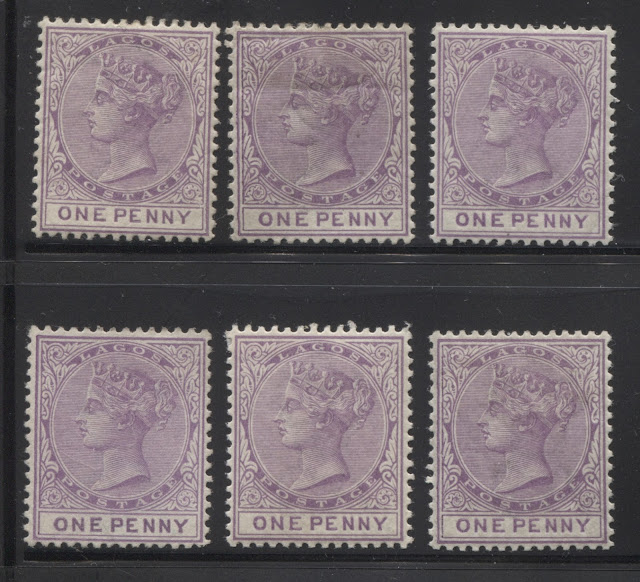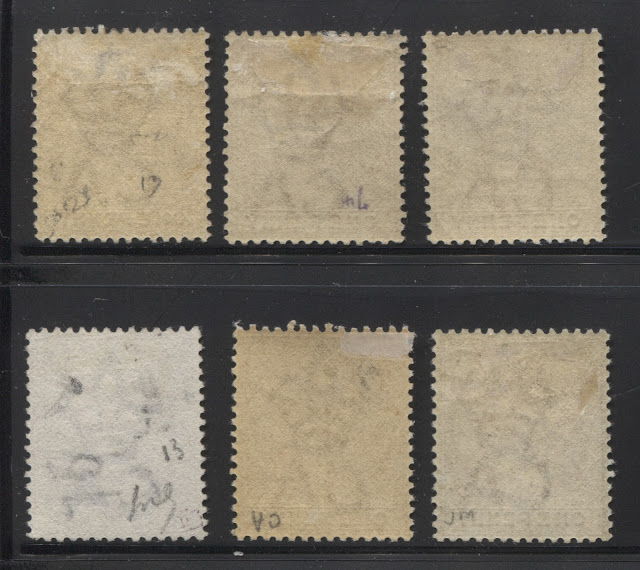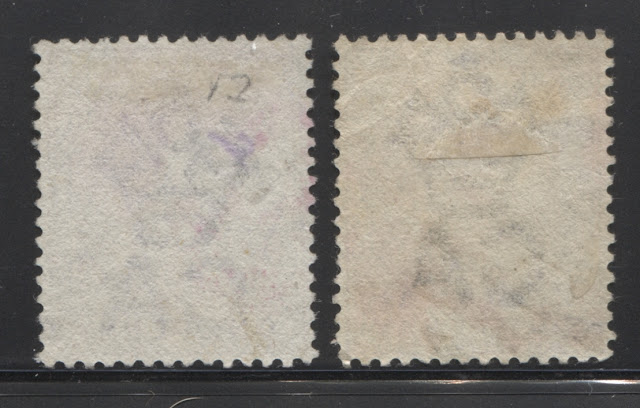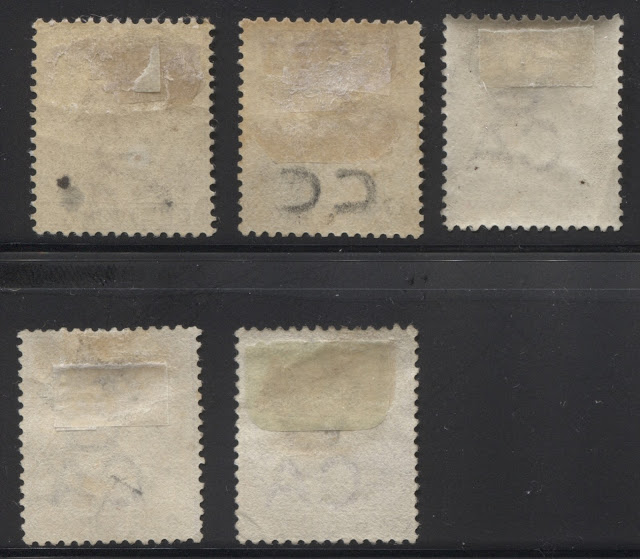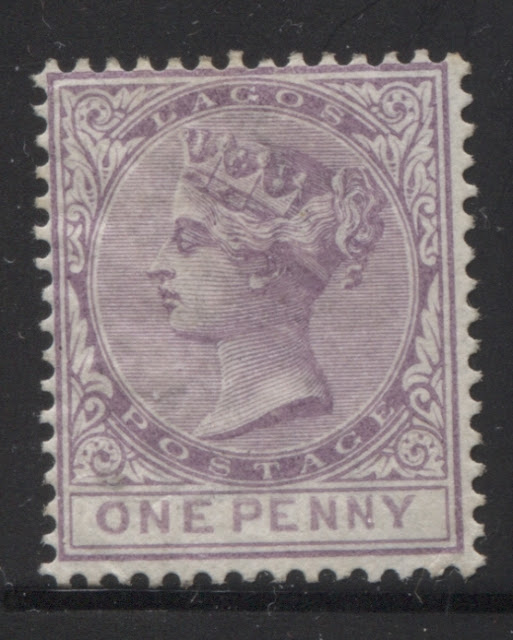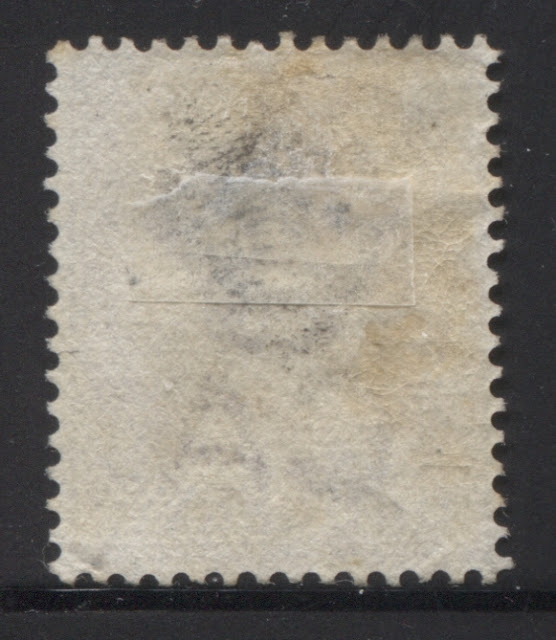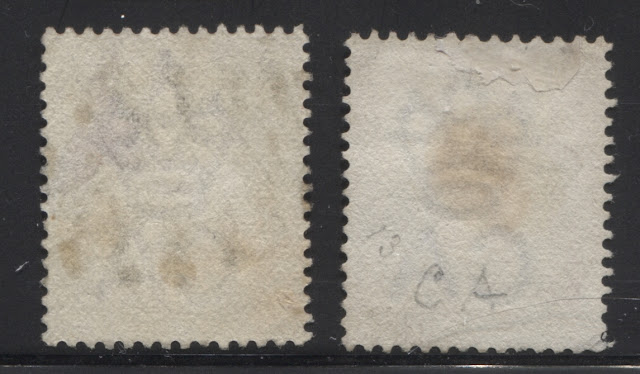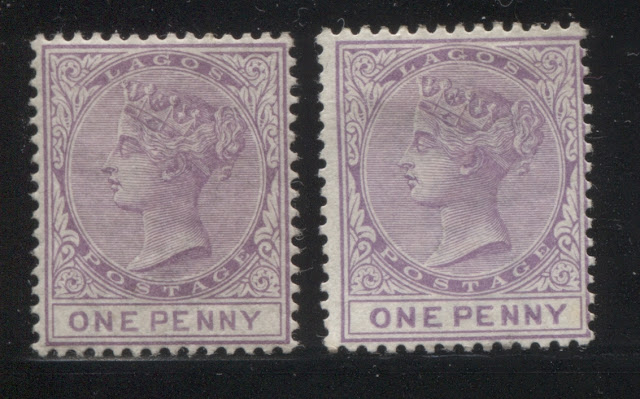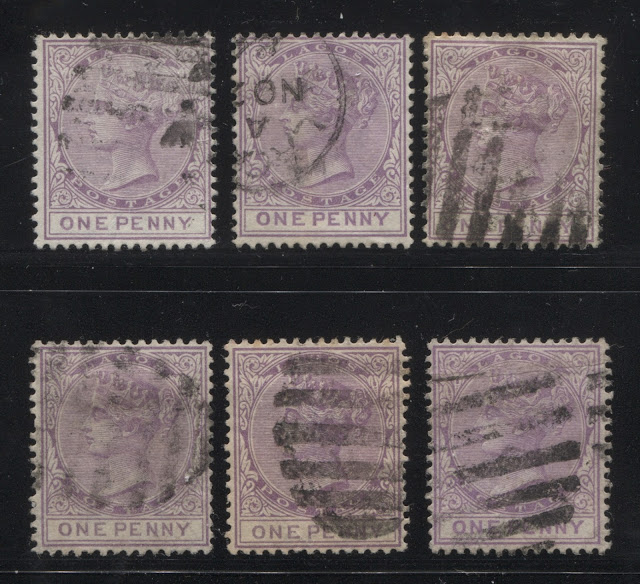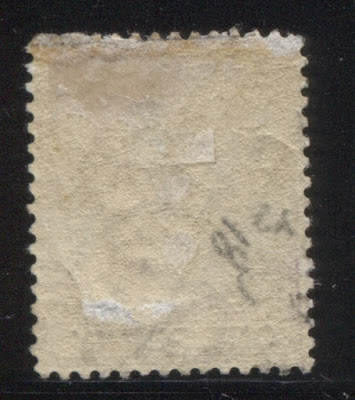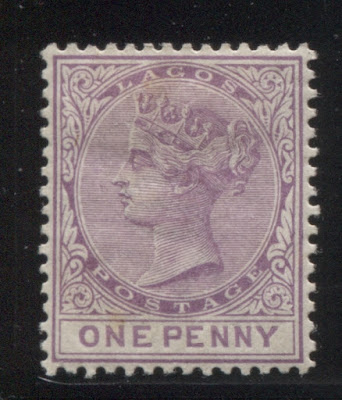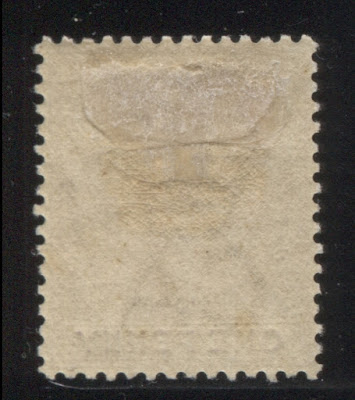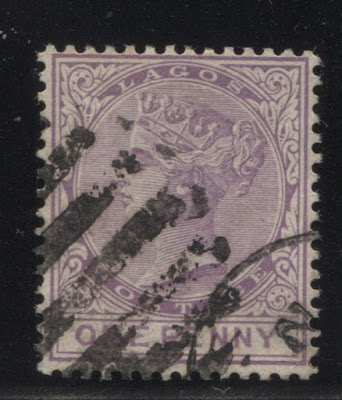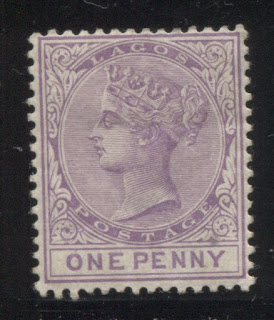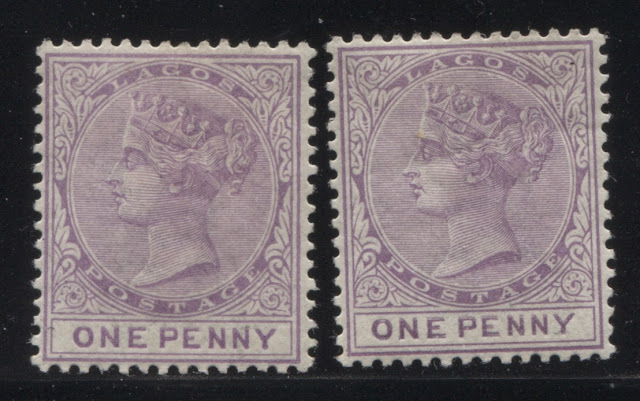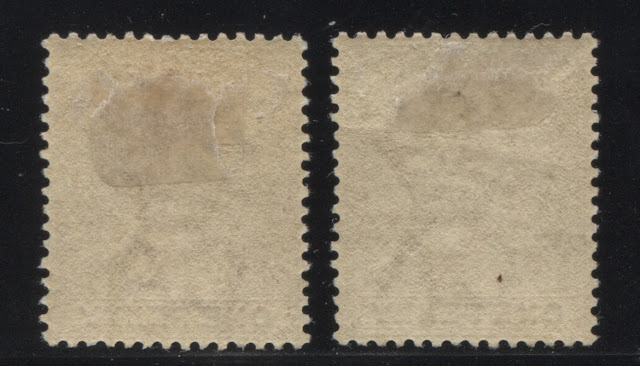Today's post begins our detailed exploration of the stamps of the 1882-1884 Crown CA keyplate issue of Lagos, that was in use briefly until the colony decided to comply with the colour regulations of the Universal Postal Union.
As I stated in my last post, Ince did not provide a detailed list of printings in his works. Because of that, coupled with the lack of dated postmarks in this period, it is not possible to definitively assign specific printings to specific dates. We do know that at this time that the colony was on the quarterly supply system with the crown agents. This means that there were shipments of stamps to the colony each and every month as they were needed. Now, this does not mean that there was a shipment of every value each quarter - only as supplies were exhausted. Historically, the 1d was included with almost every shipment. However, this was because the local postage rate was 1d per half-ounce. However, the local letter rate was raised from 1d to 2d on March 22, 1879. Thus, the only use for the 1d value during this period was for newspapers, and possibly as a makeup stamp on overweight mail. Pre-printed, private postcards had not been invented yet, so the need for 1d stamps was considerably less than before. This is borne out by the change in quantities printed:
1. The 1874-76 series produced 19,800 stamps over a 1 year period, in six shipments during that time.
2. The 1876-1879 series produced 66,600 stamps over a four year period, in four shipments, averaging 1 shipment per year.
3. This series produced 31,980 stamps over an almost four year period. The number of shipments is not known, but is likely somewhere between 4 and 6 shipments.
So I am going to sort my stock of 19 mint examples and 24 used examples with a view to seeing how many different printings I can identify.
Printings
After careful sorting and comparison, I have identified eight groups of stamps that have different colour shades as to the head plates and duty plates. I have identified one group of three very pale stamps also. However, these three stamps might be nothing more than badly faded examples. In order to be more comfortable assigning these to a specific printing, I would like to see mint examples, which will confirm that the shades did not come about as a result of fading.
Both the CDS cancel and the barred grid obilterator were contemporary during this period, although one can probably safely assign printings that are cancelled with predominantly CDS's to the last printings, while those cancelled only with the barred oval obliterators are likely to have come from the beginning of the period.
Paper and perforation are not much help here. All of the stamps are comb perforated 14. The paper is softer and of inferior quality to that found on the crown CC issues. The visibility of the watermark does vary outside fluid, from very faint, to highly visible. Usually on the back side, under a loupe, the paper will have a somewhat rough appearance. This seems to hold across all the printings, as we shall see.
The gum does vary a little bit. The earlier gum is thick and appears quite crackly under a loupe, as well as to the unaided eye. Later, as the period progresses, the gum becomes smoother and less crackly. There is however, one example here which is regummed with a very thick, shiny gum. This must of course be ignored, as the gum is not original.
First Group
Here is the scan of the first group of mint examples:
In this first group of stamps, both the head plate, and the duty plate are the exact same colour: a deep reddish lilac. There is an unmistakable reddish undertone to it.
The gum is yellowish, and is both thick and crackly:
The bottom right stamp (bottom left as seen from the back) is clearly unused without gum, but the other five copies all have full, original gum. The crackly texture is not that obvious from the scan, but is clearly visible to the eye, with and without the aid of a loupe.
Now, let's take a look at two used examples:
Although they look somewhat bluish here, they are actually quite reddish in tone. They match the mint copies above, and both are canceled with the 9-bar oval killer.
Here are the backs:
As I stated in my last post, Ince did not provide a detailed list of printings in his works. Because of that, coupled with the lack of dated postmarks in this period, it is not possible to definitively assign specific printings to specific dates. We do know that at this time that the colony was on the quarterly supply system with the crown agents. This means that there were shipments of stamps to the colony each and every month as they were needed. Now, this does not mean that there was a shipment of every value each quarter - only as supplies were exhausted. Historically, the 1d was included with almost every shipment. However, this was because the local postage rate was 1d per half-ounce. However, the local letter rate was raised from 1d to 2d on March 22, 1879. Thus, the only use for the 1d value during this period was for newspapers, and possibly as a makeup stamp on overweight mail. Pre-printed, private postcards had not been invented yet, so the need for 1d stamps was considerably less than before. This is borne out by the change in quantities printed:
1. The 1874-76 series produced 19,800 stamps over a 1 year period, in six shipments during that time.
2. The 1876-1879 series produced 66,600 stamps over a four year period, in four shipments, averaging 1 shipment per year.
3. This series produced 31,980 stamps over an almost four year period. The number of shipments is not known, but is likely somewhere between 4 and 6 shipments.
So I am going to sort my stock of 19 mint examples and 24 used examples with a view to seeing how many different printings I can identify.
Printings
After careful sorting and comparison, I have identified eight groups of stamps that have different colour shades as to the head plates and duty plates. I have identified one group of three very pale stamps also. However, these three stamps might be nothing more than badly faded examples. In order to be more comfortable assigning these to a specific printing, I would like to see mint examples, which will confirm that the shades did not come about as a result of fading.
Both the CDS cancel and the barred grid obilterator were contemporary during this period, although one can probably safely assign printings that are cancelled with predominantly CDS's to the last printings, while those cancelled only with the barred oval obliterators are likely to have come from the beginning of the period.
Paper and perforation are not much help here. All of the stamps are comb perforated 14. The paper is softer and of inferior quality to that found on the crown CC issues. The visibility of the watermark does vary outside fluid, from very faint, to highly visible. Usually on the back side, under a loupe, the paper will have a somewhat rough appearance. This seems to hold across all the printings, as we shall see.
The gum does vary a little bit. The earlier gum is thick and appears quite crackly under a loupe, as well as to the unaided eye. Later, as the period progresses, the gum becomes smoother and less crackly. There is however, one example here which is regummed with a very thick, shiny gum. This must of course be ignored, as the gum is not original.
First Group
Here is the scan of the first group of mint examples:
In this first group of stamps, both the head plate, and the duty plate are the exact same colour: a deep reddish lilac. There is an unmistakable reddish undertone to it.
The gum is yellowish, and is both thick and crackly:
The bottom right stamp (bottom left as seen from the back) is clearly unused without gum, but the other five copies all have full, original gum. The crackly texture is not that obvious from the scan, but is clearly visible to the eye, with and without the aid of a loupe.
Now, let's take a look at two used examples:
Although they look somewhat bluish here, they are actually quite reddish in tone. They match the mint copies above, and both are canceled with the 9-bar oval killer.
Here are the backs:
As you can see, the paper has a slightly rough texture, and there is really no visible mesh. The watermark is reasonably visible without watermark fluid. The finer details of it are not visible, but you can easily tell that it is crown CA without having to use fluid.
So my guess is that this may be one of the earlier printings.
Second Group
Here is the scan of the mint stamps from the second group:
In this group the colour of the head plate and duty plate is once again identical, but this time it is a much paler lilac, with a reddish undertone as well.
The gum on the two stamps at the top left, that have original gum is much smoother, without the crackly texture that the stamps of the first group had. Here is a scan of what the back of these stamps looks like:
As you can see, the bottom two stamps are unused and have no gum, with the stamp on the right showing very faint vertical mesh, whereas the bottom left stamp shows no visible mesh. The gum on the upper right stamp is very thick and shiny, and would seem to be re-gummed, as it pre-dates the introduction of double gumming in 1886. This leaves us with the first two stamps at the top, which have smooth, yellowish cream gum. Interestingly, someone has mis-identified the watermark on the top middle stamp, labeling it "CC", when it is clearly a crown CA watermark.
The used examples from this group form the largest group of used singles that I have from this issue:
Here we have three CDS's dated between May 1884 and January 1885, and five stamps canceled with the 8-bar oval obilterator. I wasn't able to determine the nature of the cancel on the third stamp in from the left on the bottom row. There is a small possibility that it might have been forged onto a mint no gum stamp in order to make it more desirable. I am not sure. Based on the mixture of cancels, this would appear to be one of the last printings.
Now let's take a look at the backs of these stamps:
Again, generally where the backs are clean, you can see no visible mesh, and the watermark is only faintly visible.
So in conclusion, based on the appearance of the gum, and the number of CDS cancels found here, I would say that this printing is one of the last, if not the last.
Group Three
I only have one mint example and two used examples from this group, so it would appear to be one of the rarer printings. Often the scarcest printings come from the middle runs, as the largest printings are usually the first and last printings.
Lets take a look at the single mint example in my possession:
Here, the duty plate colour is lighter than the head plate colour. Both are a bluish lilac that lacks the reddish undertone of the first two groups. This stamp has very little gum, but here is what the back looks like:
The gum is crackly under the loupe, what little of it there is, and the paper shows a very feint vertical mesh, just like the last printings of the 1876-1879 issue.
The two used examples that I have are both canceled with the 8-bar oval obilterator as well:
and here is the back of these two stamps:
Both stamps show faint vertical mesh in the paper, with only faint visibility of the watermark.
Given the similarity of the paper to the crown CC paper, the crackly texture of the gum, and the lack of CDS cancellations, I would venture to suggest that this might be one of the first printings, if not the very first one.
Fourth Group
The colour of the head plate an duty plate, are once again identical for the stamps in this group. The colour is much redder and milkier than the other stamps so far, being more of a mauve than a lilac. Here are the only two mint stamps in my stock:
Now for the backs:
The right stamp is unused, but the gum on the stamp at the left is almost perfectly smooth. The paper of both examples shows a faint vertical mesh. This gives conflicting indications: the gum suggests that it is a later printing, while the paper tends to suggest an earlier printing.
Now, let's look at the six used examples that I have from this group:
We have one CDS cancel dated in November 1884 - toward the end of the run, but still a full year before the last dispatch was sent to the colony. We have one one 9-bar obliterator at the bottom right, two obliterators that are likely 8-bar, but are not sufficiently complete to enable us to be certain. Finally, at the bottom centre, we have an 8-bar oval. According to Ince, the 8-bar is supposed to be an earlier type than the 9-bar. This seems to be consistent with our findings. Thus these cancellations support the classification of these as one of the later printings made sometime in 1884.
Now here are the backs:
This is a bit of a mixed bag, with the outer stamps in each row showing some faint vertical mesh, while the others show no vertical mesh.
In conclusion, I would say that this is one of the last printings, but I believe it to be earlier than the stamps of the second group above.
Fifth Group
I only have one mint stamp in this group:
The head plate is similar to the colour of the stamps in the first group above. In other words, a lilac with a reddish undertone. However, the duty plate colour is a slightly duller mauve colour.
Here is the back:
The gum is very crackly, even without a loupe. This tends to suggest that it is likely to be the first printing, or maybe the second. It is definitely earlier than the stamps of the first group above.
Sixth Group
Here I only have one mint and one used example. The colour is similar to the reddish mauve of the fourth group above. However, close examination of the words of value reveals that the duty plate is just a very small amount lighter.
Here is my mint example:
This is very close in shade to the fourth group, and it may be part of that printing. However, I have kept it separate, as there is a small difference in the duty plate colour.
The gum on the back of this stamp is relatively but not completely smooth, which suggests that it is one of the later printings:
Again, here you can just make out a faint vertical mesh, making this one of the later printings, but definitely earlier than the group 2 printings, and likely close to the time of the fourth group.
Here is my only used example"
This looks like an 8-bar oval combined with a CDS cancel, which is unusual. Now for the back:
This paper does not show any obvious mesh, which tends to suggest that it is a later printing. However, the mint example has mesh. This similar to the fourth group above, where some of the stamps show faint vertical mesh, while others do not.
Seventh Group
I have only one mint stamp from this group. The head plate and duty plate are the same colour. However, instead of being a reddish mauve, this colour is a bit more bluish. Once again, it is very similar to the stamps of group four. Here is that stamp:
The gum on this stamp is relatively smooth, just like the stamps of groups four and six:
Here there is no visible mesh. So this one may have been printed after the stamps of group four and six, but likely before group 2.
Eighth Group
In this group I have only two mint stamps. In this printing, the head plate and duty plate colours are different. The head plate is a lilac, like the first group, but with a bluish, instead of a reddish undertone. The duty plate is a deeper lilac colour.
Here is a scan of both stamps:
Note how the words of value are a slightly darker colour than the rest of the stamp.
The gum on these two stamps is about mid-way between smooth and crackly:
There is no obvious mesh visible here. This suggests that this is one of the middle printings.
Preliminary Conclusiuon About the Order of the Printings
Based on the various characteristics of each group of stamps, I believe that the order of the printings is as follows:
- First - fifth group
- Second - third group
- Third - first group.
- Fourth - eighth group
- Fifth - fourth groupp
- Sixth - sixth group
- Seventh - seventh group
- Eighth - second group
This is all purely conjectural and may change as I examine more stamps and learn more about this issue.
That takes me to the end of the 1d. Next week I will look at the 2d blue, which I believe had many more printings than the 1d did, largely because 2d stamps were used to mail regular inland letters.


